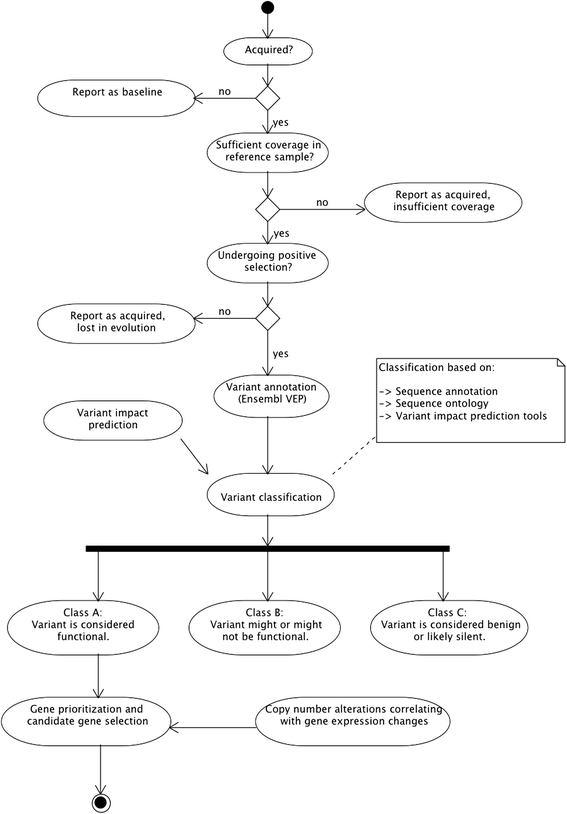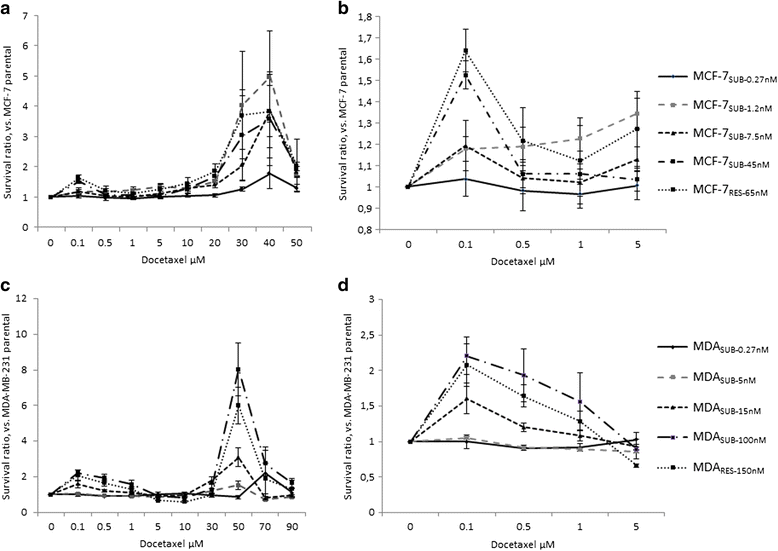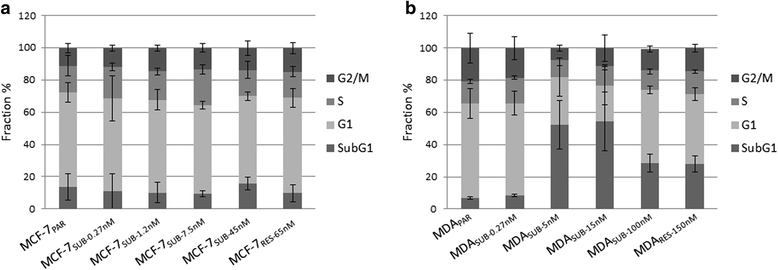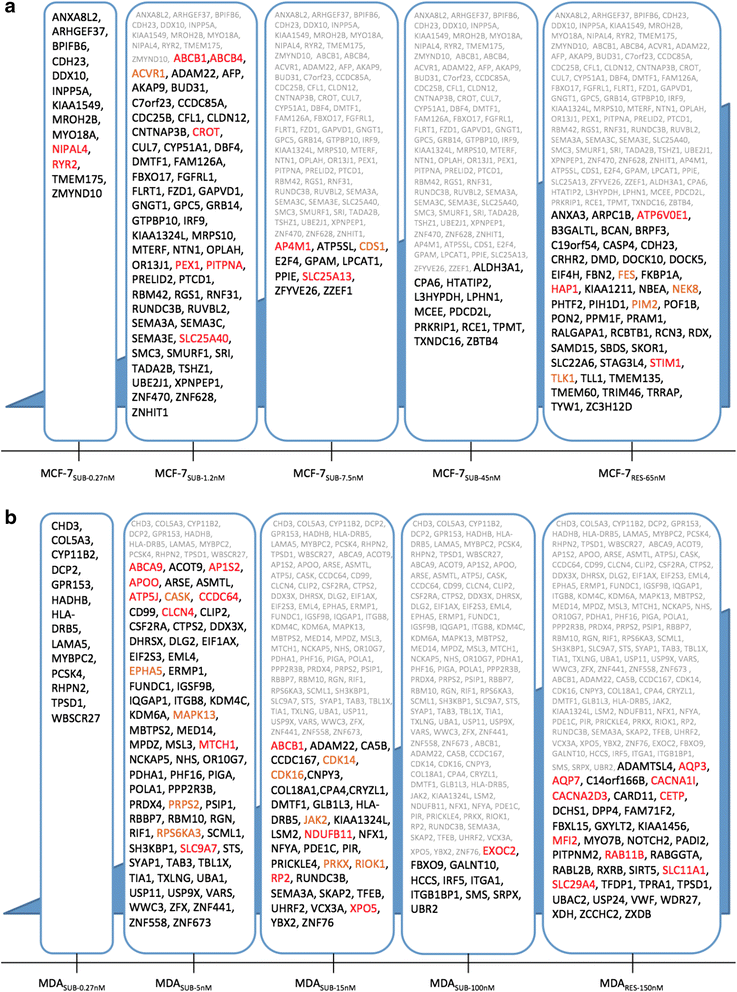The stepwise evolution of the exome during acquisition of docetaxel resistance in breast cancer cells
- PMID: 27277198
- PMCID: PMC4899892
- DOI: 10.1186/s12864-016-2749-4
The stepwise evolution of the exome during acquisition of docetaxel resistance in breast cancer cells
Abstract
Background: Resistance to taxane-based therapy in breast cancer patients is a major clinical problem that may be addressed through insight of the genomic alterations leading to taxane resistance in breast cancer cells. In the current study we used whole exome sequencing to discover somatic genomic alterations, evolving across evolutionary stages during the acquisition of docetaxel resistance in breast cancer cell lines.
Results: Two human breast cancer in vitro models (MCF-7 and MDA-MB-231) of the step-wise acquisition of docetaxel resistance were developed by exposing cells to 18 gradually increasing concentrations of docetaxel. Whole exome sequencing performed at five successive stages during this process was used to identify single point mutational events, insertions/deletions and copy number alterations associated with the acquisition of docetaxel resistance. Acquired coding variation undergoing positive selection and harboring characteristics likely to be functional were further prioritized using network-based approaches. A number of genomic changes were found to be undergoing evolutionary selection, some of which were likely to be functional. Of the five stages of progression toward resistance, most resistance relevant genomic variation appeared to arise midway towards fully resistant cells corresponding to passage 31 (5 nM docetaxel) for MDA-MB-231 and passage 16 (1.2 nM docetaxel) for MCF-7, and where the cells also exhibited a period of reduced growth rate or arrest, respectively. MCF-7 cell acquired several copy number gains on chromosome 7, including ABC transporter genes, including ABCB1 and ABCB4, as well as DMTF1, CLDN12, CROT, and SRI. For MDA-MB-231 numerous copy number losses on chromosome X involving more than 30 genes was observed. Of these genes, CASK, POLA1, PRDX4, MED14 and PIGA were highly prioritized by the applied network-based gene ranking approach. At higher docetaxel concentration MCF-7 subclones exhibited a copy number loss in E2F4, and the gene encoding this important transcription factor was down-regulated in MCF-7 resistant cells.
Conclusions: Our study of the evolution of acquired docetaxel resistance identified several genomic changes that might explain development of docetaxel resistance. Interestingly, the most relevant resistance-associated changes appeared to originate midway through the evolution towards fully resistant cell lines. Our data suggest that no single genomic event sufficiently predicts resistance to docetaxel, but require genomic alterations affecting multiple pathways that in concert establish the final resistance stage.
Keywords: Breast cancer; Docetaxel resistance; Exome sequencing; Taxane.
Figures




Similar articles
-
Acquisition of docetaxel resistance in breast cancer cells reveals upregulation of ABCB1 expression as a key mediator of resistance accompanied by discrete upregulation of other specific genes and pathways.Tumour Biol. 2015 Jun;36(6):4327-38. doi: 10.1007/s13277-015-3072-4. Epub 2015 Jan 18. Tumour Biol. 2015. PMID: 25596703
-
Hypermethylation of the ABCB1 downstream gene promoter accompanies ABCB1 gene amplification and increased expression in docetaxel-resistant MCF-7 breast tumor cells.Epigenetics. 2008 Sep;3(5):270-80. doi: 10.4161/epi.3.5.6868. Epigenetics. 2008. PMID: 19001875
-
MicroRNA-3646 Contributes to Docetaxel Resistance in Human Breast Cancer Cells by GSK-3β/β-Catenin Signaling Pathway.PLoS One. 2016 Apr 5;11(4):e0153194. doi: 10.1371/journal.pone.0153194. eCollection 2016. PLoS One. 2016. PMID: 27045586 Free PMC article.
-
Not only P-glycoprotein: Amplification of the ABCB1-containing chromosome region 7q21 confers multidrug resistance upon cancer cells by coordinated overexpression of an assortment of resistance-related proteins.Drug Resist Updat. 2017 May;32:23-46. doi: 10.1016/j.drup.2017.10.003. Epub 2017 Oct 16. Drug Resist Updat. 2017. PMID: 29145976 Review.
-
Taxane resistance in breast cancer: mechanisms, predictive biomarkers and circumvention strategies.Cancer Treat Rev. 2012 Nov;38(7):890-903. doi: 10.1016/j.ctrv.2012.02.011. Epub 2012 Mar 31. Cancer Treat Rev. 2012. PMID: 22465195 Review.
Cited by
-
A Comprehensive RNA Study to Identify circRNA and miRNA Biomarkers for Docetaxel Resistance in Breast Cancer.Front Oncol. 2021 May 14;11:669270. doi: 10.3389/fonc.2021.669270. eCollection 2021. Front Oncol. 2021. PMID: 34055636 Free PMC article.
-
MiR-361-5p suppresses chemoresistance of gastric cancer cells by targeting FOXM1 via the PI3K/Akt/mTOR pathway.Oncotarget. 2017 Dec 20;9(4):4886-4896. doi: 10.18632/oncotarget.23513. eCollection 2018 Jan 12. Oncotarget. 2017. PMID: 29435149 Free PMC article.
-
lncRNA profile study reveals the mRNAs and lncRNAs associated with docetaxel resistance in breast cancer cells.Sci Rep. 2018 Dec 19;8(1):17970. doi: 10.1038/s41598-018-36231-4. Sci Rep. 2018. PMID: 30568280 Free PMC article.
-
Experimental Design, Population Dynamics, and Diversity in Microbial Experimental Evolution.Microbiol Mol Biol Rev. 2018 Jul 25;82(3):e00008-18. doi: 10.1128/MMBR.00008-18. Print 2018 Sep. Microbiol Mol Biol Rev. 2018. PMID: 30045954 Free PMC article. Review.
-
BAG3 Overexpression and Cytoprotective Autophagy Mediate Apoptosis Resistance in Chemoresistant Breast Cancer Cells.Neoplasia. 2018 Mar;20(3):263-279. doi: 10.1016/j.neo.2018.01.001. Epub 2018 Feb 22. Neoplasia. 2018. PMID: 29462756 Free PMC article.
References
-
- Arriola E, Rodriguez-Pinilla SM, Lambros MB, Jones RL, James M, Savage K, Smith IE, Dowsett M, Reis-Filho JS. Topoisomerase II alpha amplification may predict benefit from adjuvant anthracyclines in HER2 positive early breast cancer. Breast Cancer Res Treat. 2007;106:181–9. doi: 10.1007/s10549-006-9492-5. - DOI - PubMed
-
- Di Leo A, Desmedt C, Bartlett JM, Piette F, Ejlertsen B, Pritchard KI, Larsimont D, Poole C, Isola J, Earl H, Mouridsen H, O’Malley FP, Cardoso F, Tanner M, Munro A, Twelves CJ, Sotiriou C, Shepherd L, Cameron D, Piccart M, Buyse M. HER2 and TOP2A as predictive markers for anthracycline- containing chemotherapy regimens as adjuvant treatment of breast cancer: a meta-analysis of individual patient data. Lancet Oncology. 2011;12:1134–42. doi: 10.1016/S1470-2045(11)70231-5. - DOI - PubMed
-
- De Laurentiis M, Cancello G, D’Agostino D, Giuliano M, Giordano A, Montagna E, Lauria R, Forestieri V, Esposito A, Silvestro L, Pennacchio R, Criscitiello C, Montanino A, Limite G, Bianco A, De Placido S. Taxane-based combinations as adjuvant chemotherapy of early breast cancer: a meta-analysis of randomized trials. J Clin Oncol. 2008;26:44–53. doi: 10.1200/JCO.2007.11.3787. - DOI - PubMed
MeSH terms
Substances
LinkOut - more resources
Full Text Sources
Other Literature Sources
Medical
Research Materials
Miscellaneous

